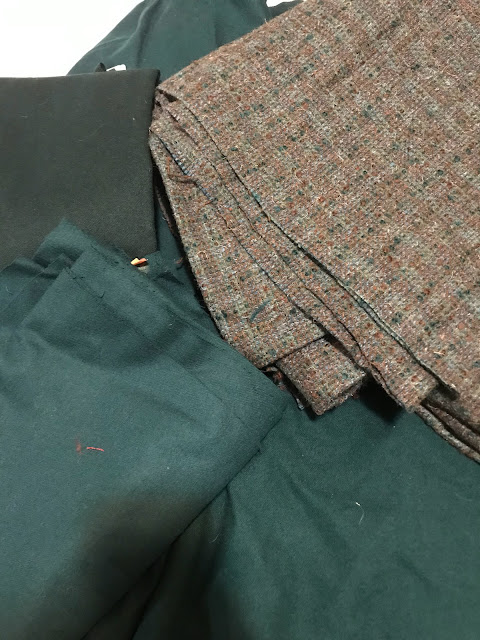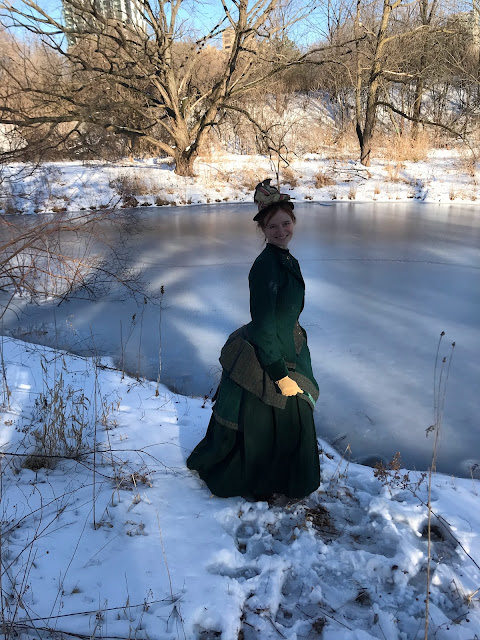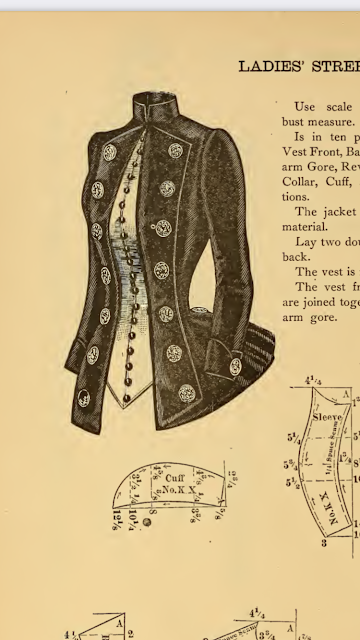The plan for the St. Louis Historical Sewing Society ice skating outing was announced last summer, giving everyone interested in attending plenty of time to plan and make ice skating ensembles. I, being the fantastic procrastinator that I am, didn't actually start making my outfit until less than a month before the event (and most of it was sewn the week of the event. . .). But that's not the point! The point is I had plenty of time to work of this outfit if I had so chosen, and I spent this time working on other projects while dreaming, planning, and researching what sort of ice skating outfit I wanted!
As soon as the event was announced I knew I wanted a bustle dress. I made myself a couple of lobster tail bustles from the Truly Victorian pattern about 2 years ago, and I have been incredibly slow at making anything to wear with those bustles. I needed to make a bustle dress!
Thus a vague style and era of dress was chosen, but what would I make it out of? and what would it actually look like? and did I want early bustle (1870's) or late bustle (1880's)?
As I believe I've mentioned in the past, I have an impressive stash of wool. (If I do say so myself.) I love wool, so I collect it. I've been given a good amount of wool by people destashing and such. Along with that, any time I find wool at a thrift store, I buy it, and I also collect wool skirts from thrift stores to disassemble and use for fabric. Occasionally I'll buy wool yardage when I find it on sale. And then I'll end up with more wool when someone else is destashing. The result? A heck ton of wool stored in my parents' basement. I was not going to need to buy any wool for this project!
 |
| My wool stash as of 3 years ago - it has grown since then. |
There is only one issue with my stash of wool. While there are a few larger (4+ yards) cuts of wool, it primarily consists of 1.5 - 2.5 yard cuts of wool. This is not ideal for making fabulous historical gowns that require a minimum of 6 yards of material. Not ideal at all. But I'm creative, and I had a plan to get around this potential fabric shortage issue when it came to making my skating dress.
Dark green is one of my very favorite colors, so out of my stash came all my dark green wools - 3 dark green Pendleton wool skirts (2 identical, just different sizes, and one a slightly different shade of green), a 2 yard cut of a very dark green wool flannel, a 1.5 yard cut of a wool flannel the same shade as the matching skirts, and a 2.5ish yard cut of a green and brown wool tweed.
 |
| The pictures don't accurately show the color of the tweed, it's much more green in real life. |
Fabrics gathered, I needed to pick a design that would work with what I had. After months of casually browsing Pinterest for something that caught my eye, I settled on the dress on the right/in the middle of this 1884 fashion plate.
First I made myself a new set of apportioning rulers, as unfortunately my original rulers from 4 years ago got misplaced in one of my sewing room moves. In this blog post I go all into how to do the math and make your own rulers. This time, however, I was feeling lazy and didn't want to mess with the math so I used the proportional measurements from this e-book instead to make my rulers.














Fascinating! I'm not a historical costumer, just an ordinary home sewer. I enjoy very much reading about the creating the garment, starting with the vision, and finding the patterns and fabrics to achieve that, with what's available. Not to mention getting a correct fit for the wearer and the style. Thanks for posting!
ReplyDeleteSO impressed by your historical re-fashion project! I always love a good stash busting story! Your outfit is fantastic - great job. The tweed texture and the rich green are *chefs kiss*. I am impressed at how you were able to find free patterns for just what you wanted...I didn't know such an archive like that was out there. I have yet to try a pattern that demands an apportioning ruler - they intimidate me! I currently spend most of my pattern drafting time resizing up my tiny sized and teenage proportioned vintage patterns (they are always cheaper being so small)!
ReplyDeleteVeeery nice! Great job as always. :-)
ReplyDelete